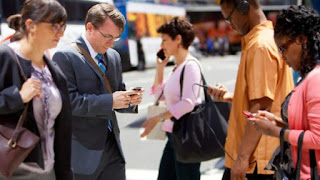When real
communication ends and the digital connection is at its maximum
Marc
Prensky says that our generation learned to understand the world through
reading, and that now children learn to understand the world through
technology. Reading is still the basic competence to learn, only the way of
reading is different: The format of XXI and XX centuries was the paper books;
In the 21st century, there are more media and formats available, analog and
digital.
The
medium, the format and the accessibility to the medium are the three aspects
that show the difference between the forms of reading of the nineteenth,
twentieth and twenty-first centuries. Do children read today less than before?
In schools, by obligation or voluntarily, they read textbooks, stories, novels,
instructions for video games and apps, tweets, posts, messages in chats, news
from their favorite bloggers, websites. They read on paper or on computers,
tablets, smartphones, e-readers. Why so much format and medium? Because they
are digital natives.
Is
reading on paper better to acquire a taste for reading? Is handwriting better
than in digital media? Actually, it does not matter, as long as they know how
to read and write, and appreciate the value of reading. The good or bad that
you choose will depend on your criteria and ability to analyze. Therefore, what
must be taught urgently is the critical spirit, the ability to value, judge and
choose; This ability will be useful for a lifetime.
A
medium accessible to everyone in the smartphone that has the capacity for
everything, which allows reading and writing in multiple formats and media. The
problem is that, due to its characteristics and functions, it has created a new
form of addiction, which affects 50% of adolescents and the same or greater
number of adults. No one escapes the charm and seduction of this omnipotent and
omnipresent tool.
A
group of researchers (NGO Como Cense) presented a questionnaire to 1,240
parents and adolescents (12 to 18 years old) as a follow-up on the consequences
of dependence. The data indicated that at least half of the adolescents were
mobile addicts and 60% of the parents felt the same. Young people spent too
much time with the Smartphone; they continually distracted themselves, reviewed
or checked their notifications on the mobile phone at least every hour, and
felt the need to instantly respond to social media messages.
Strong
addictions can not be cut abruptly. If parents totally eliminate the
"object of desire" (smart phone) they can generate important
emotional reactions such as the breakdown of the father-child relationship,
because this decision also cuts the umbilical cord of the young man's
relationship with his friends. It is a dilemma because you live in a
paradoxical era. "We live in the times of communication, but we are
increasingly isolated from each other". "When we have a coffee with
our partner or with our friend, and we are both with the phone, we are
disconnected from the other person, but connected with a device that supposedly
connects us with her." Curious? Dangerous? Funny?
To
connect with a person who is in front of us, we must look at her, talk, see her
gestures and touch her. When the phone is used and abused, none of the above
happens, the person is forgotten and isolation is generated, a kind of autism.
More and more people are enrolled in a society of solipsism where each one is
on their own, without goals or social and collective objectives; supposedly
connected, but really alien and disconnected even from the people who are in
front of us and next to us. More and more together but absent, while the
smartphone consolidates its kingdom and subdues its blind and clueless
subjects.
References









